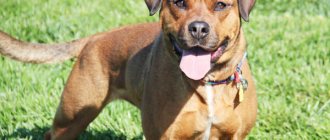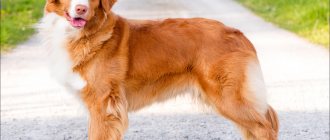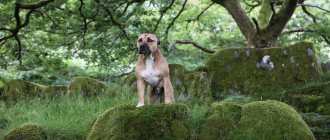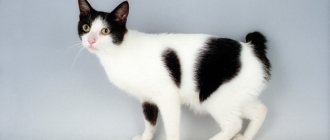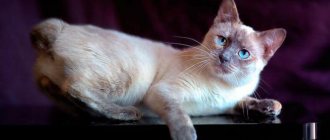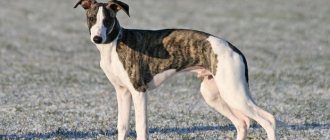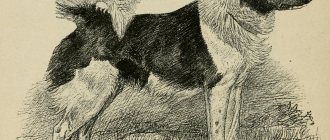| Origin: | Great Britain |
| Usage: | herding dog, companion |
| Color: | grey, blue, grizzly |
| Dimensions: | height from 56 cm in females, from 61 cm in males, weight from 27 to 45 kg |
| Lifespan: | 10-12 years |
The Bobtail is a dog with an extraordinary soul and spectacular appearance. This is the most devoted and loyal friend you can imagine. Animals appeal to both beginners and experienced dog breeders - it’s easy to find an approach to them. The article describes what the breed is, its maintenance and care features.
Breed standard
The Bobtail is a strong, compact dog with a square build. Animals are perfectly adapted to perform their direct duties - they are mobile, efficient and hardworking.
Dogs grow large: the minimum height for females is 56 cm, for males - 61 cm. How much weight the animal will have depends on the height at the withers. The standard does not provide clear guidance on this matter. There are dogs weighing both 28 kg and 45 kg. But the females are somewhat smaller and more graceful than the males.
| Official description of the breed (FCI standard No. 16): | |
| Become | Breed characteristics |
| Head | Proportional, with an almost square skull and well-defined stop. |
| Ears | Small, hanging, pressed to the head. |
| Nose | Large, black lobe. |
| Jaws | Powerful, set in a scissor bite. A straight bite is acceptable, but not encouraged. |
| Eyes | Widely spaced. The color of the iris is dark. Heterochromia is acceptable. The look is smart and intelligent. In a photo of a dog, the eyes are usually not visible because they are hidden by the bangs. |
| Neck | Quite long, muscular, gracefully curved. |
| Body | The chest is voluminous. The loin is located above the withers. |
| Tail | Previously, it was subject to docking at birth, now the owner decides the issue. Naturally short, covered with thick fur. Because of this feature, the breed was called “bobtail,” which translates as “bumpy tail.” |
| Limbs | Powerful, provide stability and freedom of movement for the animal. Paws point straight. The fingers are short, the pads are dense and hard. |
A characteristic feature of the bobtail dog is its shaggy fur, which provides excellent protection from heat and cold. The dense undercoat repels moisture, keeping the body dry. The guard hair is wavy but not curly. Allowed colors are any shades of gray or blue. The feet, head, neck and belly may be white. Brown or reddish colors are considered a fault. You can see what an Old English Sheepdog looks like in the photo.
The breed has an unusual gait - it waddles, like a bear. The running is smooth and energetic, with good thrust of the forelimbs and powerful drive of the hind limbs. Slowing down, many dogs begin to amble. At the same time, they characteristically sway left and right.
Aggressive, cowardly bobtails, as well as dogs with physical or behavioral abnormalities are subject to disqualification.
Where to buy a bobtail puppy – tips and tricks
If you want to get a bobtail dog, it is better to contact specialized kennels. Breeders usually offer tested, purebred puppies that meet all standards.
Reference. There are several nurseries in Russia offering to buy purebred bobtails for professional and home breeding. The cost of puppies is approximately 15-45 thousand rubles.
A young dog should look healthy, cheerful, slightly well-fed
When choosing a puppy, you should pay attention to its appearance. A young dog should look healthy, cheerful, slightly well-fed, behave actively, and have a confident and even gait. Be sure to check the baby’s bite: according to standards, the upper jaw will stand straight or slightly extend beyond the lower jaw. The color must comply with the breed standards. A pink or gray nose color will be considered a defect.
Some famous nurseries:
- https://bobtail-vl.ru/;
- https://bobtailclub.ru/
- https://sky-bobtail.narod.ru/oes.html;
- https://abigal1.narod.ru/;
- https://bobtail-angel.ru;
- https://bobtail-dozor.ru/.
Video – Bobtail dog
Character
The Bobtail is a kind and calm dog. She has an obedient, affectionate and balanced character. The animal subtly senses the mood of the owner. If a person is sad, the dog will try to do everything in his power to make him smile.
Old English Sheepdogs do not strive to dominate and are distinguished by their keen intelligence. Bobtail training is easy - the dog happily follows commands if the owner sincerely praises it and rejoices at its success. You can teach your pet various tricks - everything is limited only by the owner’s imagination.
Training a bobtail shepherd is also effortless. It is enough to awaken the animal’s innate instincts. The Old English Sheepdog will learn the rest on its own, looking at older and more experienced comrades.
Origin story
Several centuries ago, when bobtails were first bred, their temperament was much more severe, which was required by their status as a universal farmer's dog. Presumably, its ancestors are the Briard and the South Russian Shepherd Dog.
The name "Bobtail" comes from two English words that mean "short tail". If puppies with a long tail were born in the litter, it was docked. But not only for aesthetic or practical reasons. In England at that time, shepherds were required to pay a tax for a dog, and the amount was greater, the longer the dog’s tail. The ancestors of the modern bobtail were distinguished by rough habits and a somewhat loose physique. They were used primarily as guards and beaters, and more agile collies were often used to help.
For the first time, the original beauty of the bobtail attracted public attention at an exhibition in 1873, when the dogs were already exhibited as a separate breed. 15 years later, the first breed club was organized, and former village dogs began to appear on the lawns of the living rooms of the English elite. Breeders, in turn, continued to test the working qualities of the breed, but at the same time tried to soften its appearance and character. As a result, the bobtail has transformed from a rough dog into a charming family dog.
Application
The Old English Sheepdog has an innate herding instinct. A bobtail dog is able to control a herd of cattle of up to 100 heads. However, now animals are more often kept as companions. They are infinitely loyal to their owner, non-aggressive and calm.
At the same time, the dog can become a good watchman. In this case, it is advisable that the bobtail dog undergo a course in protective guard service. She will learn to behave correctly in an extreme situation and quickly analyze current events. Given the large size and rough voice of the Old English Sheepdog, there are few who want to conflict with a serious animal.
Animals are often used as guide dogs and are involved in working with children with physical and mental disabilities.
Training and preparation for the exhibition
The Old English Sheepdog quickly remembers commands. She is obedient and hardly tries to dominate, so she can be recommended for beginners.
It is important from the very first days to show the puppy that you are the leader in the relationship. Since the bobtail is a herding dog, it may try to “herd” everyone around it (preventing them from moving aside, etc.). This should be crossed with the command “Ugh!”
Training must be carried out patiently and confidently, without haste or nervousness. For correct execution of commands, the dog should receive a reward in the form of a treat or praise.
In order for the Old English Sheepdog to participate in exhibitions, it must master special running and standing. At the end of each walk, take your dog for a leisurely run in a straight line, a 180-degree turn, and in a triangle shape. The dog must stay next to the owner's leg at all times. The leash cannot be pulled. At the end, run around a small circle and stop so that the dog freezes with its left side towards the center (an expert will stand there at the exhibition). The head should be raised. Gradually increase the time of the stand, bringing it to two minutes. Repeat these exercises 2-3 times daily.
Similar article: How to keep a Mongolian Shepherd Dog
Socialization
Socialization of an Old English Sheepdog puppy begins immediately after it arrives in the home. It is better to initially choose babies who grew up in close contact with people. Obedience must always be sought from the animal, but physical force must not be used. Bobtails take grievances hard, and emotional comfort is the main condition for their happy life.
The Old English Sheepdog is indifferent to its relatives, does not conflict with other pets, and adores children. The bobtail dog is ready to tinker with the kids, like a four-legged nanny. Reviews from the owners confirm that this is a unique dog in its own way - smart, peaceful, sociable, loyal and selfless.
Price of puppies
The average price of a puppy ranges from $700 to $1200, it all depends on which nursery and from which parents you get the animal.
That's all the basic information about such a wonderful breed as the Old English Sheepdog, or Bobtail. You definitely won’t get bored with this animal - by getting one, you can buy yourself a cheerful companion and a reliable friend for the next 12 years. And with proper care, the dog will also attract admiring glances.
How to choose a puppy
A bobtail puppy will require a lot of attention. If the future owner is not sure that he will be able to devote enough time to the pet, it is better to refuse the purchase. With proper upbringing, dogs grow into loyal friends capable of babysitting children and protecting the home.
Before choosing a bobtail puppy, you should get to know its parents. Healthy and large dogs with a stable psyche will produce the same offspring.
Old English Sheepdog puppies are active and curious. They have shiny eyes, a moist nose and a clean coat without an unpleasant odor. To participate in exhibitions, it is better to buy grown-up juniors when the opportunity arises to evaluate their exterior. The breeder must provide a veterinary passport and registration of the dog.
At birth, bobtail puppies are white and black in color. Over time, the color changes to gray or blue.
History of the breed
Bobtail throughout history has never had anything to do with the aristocracy. The breed was bred in Europe, in the territory of modern Spain, France and Andorra. The purpose of dogs is to serve farms: the huge shaggy dogs performed guard, hunting and shepherding duties flawlessly.
Around 2500 BC, bobtails also appeared in England, where they very quickly spread throughout the territory. The aristocracy's contempt for the "yard" dog was more than compensated by the attitude of the farmers - the universal dog became indispensable.
From 476 to 1500, the breed was divided into several types: English, Welsh and French bobtails. The dog's responsibilities have become more specific.
- Help the shepherd manage his flocks of sheep.
- Protecting the herd from predators and robbers.
- Home protection.
Shepherds used bobtails as herding dogs, leading the herd in a given direction, and faster collies helped them from the sides. The dogs, which were not too agile, were good at herding the herd into a dense formation. Strong dogs actively helped drive the sheep into the river for washing in order to improve the quality of the wool.
By this time, there were no large predators left in England that could cope with a huge dog, and tramps, who had their eye on a sheep in the herd, refused to kidnap animals at the sight of a bobtail’s grin.
In their free time from grazing, the reliable dogs were responsible for protecting the farm from any intruder - human or animal. Any violator was instantly attacked by a powerful dog.
By the 11th century, the bobtail could be seen on almost every farm in England. Due to the lack of permanent transport links, dogs differed in different parts of the country, representing local species. In neighboring areas, both tailed and tailless bobtails could be found.
In the south of the country the breed was not in demand until the 18th century. The author of the 1879 book "Dogs", William Yatt, quotes contemporaries who claim that dogs of this breed are the result of a mixture with a long-haired water dog. Such dogs are large and muscular, they have an awkward build, coarse hair and no tail.
The first images appeared much later - who would think of drawing a “dirty farmer’s shepherd dog”? For a self-respecting gentleman, standing next to her is unpleasant.
Despite the disdainful attitude of the aristocrats, the demand among villagers for unpretentious, powerful dogs only increased. And in the 19th century, Mr. Richard Lloyd Prince opened a kennel in North Wales, where he began to breed and improve the breed of “Old English Sheepdogs” - it was under this name that the breed appeared until the end of the century.
In England there was a law that stipulated a tax on dogs. Its value depended on the length of the animal's tail. This is why farmers docked the tails of their helpers. The modern name of the breed indicates this fact. The literal translation is “short-cut tail.”
At the dog show in Ismington in 1865, dogs of this breed were first presented. Two dogs without pedigrees, both named Bob.
In 1888, the first Old English Sheepdog Club was created. The names of the people who determined the direction of development of the breed and its subspecies, unfortunately, have not been preserved. But bobtails acquire a more aristocratic appearance and receive the prefix “Sir” or “Lady” to their nicknames.
We advise you to read: Bull Terrier Dog Breed
By the end of the century, interest in bobtails increased. They began to be seen as companions and show dogs. Demand creates supply, and enterprising people began to open specialized kennels. Among the owners there were both true connoisseurs of the breed and businessmen focused only on making a profit.
To breed outstanding representatives of the breed, dogs began to be bought in villages, offering small, but significant money for farmers, for a high-quality dog. The scammers sold not only tailless shepherd dogs, but also tailed ones, after docking the tail. Experienced breeders easily distinguished the “fake”; technology did not allow hiding the scars in place of the tail.
Articles about dog breeds in various publications, such as the Sportsman's Cabinet, were written mainly by “real” gentlemen, full of arrogance, but without knowledge about the dogs being described. One of these “experts” was Revdon Lee, who worked as editor of the dog section of Field magazine. Thanks to his efforts, the description of bobtails of that time suffers from contradictions and inaccuracies.
Lee, in his book "Collies and Sheepdogs" in 1890, writes that those who like Old English Sheepdogs admire the obedience and intelligence of these dogs, "rave" something about the beauty of the eyes and impressive coat, while haters point to a tendency to be cunning, cunning and unattractiveness breed for an “educated” person, such a misunderstanding has nothing to do in the house - let it wander in the fields. What can we talk about if even the collie club refused to recognize the Old English breed. Individual enthusiasts had to organize their own club.
Another gentleman, Ideston, writes that the Old English Sheepdog understands only a cry, and the punishment for it can be a strong kick with a heel.
At the same time, there were those who liked the breed. Since 1873, when the first official display of bobtails took place at an exhibition, they began to be used as companions and as show dogs - both in the Old and New Worlds. Dog lovers were impressed by the rugged cuteness and unusual appearance of the Old English Sheepdog.
The first bright representatives of the breed appeared in Wales. We should also mention Dr. Edward Kehr, who invested a lot of effort in producing high-quality Old English Sheepdogs.
The first known champion dog, Jokey, is described as a smooth-haired dog. The reason for this is the usual haircut for bobtails of that time, for the hygiene and convenience of the owner.
Today, most representatives of the breed are companions who take part in exhibitions and shows. Only a small number are used for their intended purpose - as herding sheepdogs. As a result of careful work on the breed, selection, anger and willfulness were removed from the character of bobtails, and the hair became even thicker and longer.
Features of maintenance and care
The Bobtail is perfectly suited for life on the street - it is not afraid of rain and frost. However, when alone, the animal becomes very sad, so the owner must regularly set aside time for communication and joint games.
If given a long walk, the Old English Bobtail Sheepdog feels good in an apartment. The pet loves when the whole family gets together and enjoys spending time with people.
Grooming
Coat care requires special attention. Animals are combed 3-4 times a week, and daily during the molting period. If the old fur is not removed in time, the bobtail will develop dermatitis, or in the worst case, demodicosis or eczema. Experienced dog breeders recommend trimming their pets twice a year.
Many owners trim their dogs. A cropped bobtail loses its natural charm, but maintaining a short coat in neat condition is much easier. To prevent bangs from covering your eyes, they are tied into ponytails or slightly shortened. The fur between the paw pads is removed, otherwise the animal will slide on smooth surfaces.
English farmers sheared dogs and spun fur. Things turned out warm and soft.
Bobtail care also includes periodic cleaning of the ears, eyes and teeth. If necessary, the animal's claws are trimmed.
Bathing
Dogs are bathed approximately once a month. There is no need to do this more often - the fur will lose its natural protective shell.
Walk
Representatives of the Bobtail dog breed love jogging. Active physical exercise helps them stay in good shape, which is especially important when living in apartments. Animals are walked twice a day for at least 60 minutes.
Feeding
Old English Sheepdogs are given super-premium food or prepared with natural food. In the latter case, the bobtail diet consists of:
- meat and offal;
- sea fish;
- croup;
- vegetables;
- fermented milk products.
In agreement with the veterinarian, vitamin and mineral complexes are administered.
Two-month-old puppies are fed 6 times a day. Gradually the frequency is reduced. By the age of one year, food is given twice: in the morning and in the evening. After eating, you should not load the dog, otherwise digestive problems will arise.
Bobtails do not have an upper height limit, so the weight of puppies can vary greatly. The main thing is to provide your baby with a balanced diet.
Character and behavioral characteristics
The Bobtail is a one-owner dog. Having found a leader and a higher creature in the owner, the pet will be selflessly devoted all its life. This does not mean that he will treat the rest of the family poorly: representatives of the breed are friendly and playful, with great joy they will devote time and attention to everyone.
The Bobtail does not tolerate loneliness well: if left alone for a long time, the dog becomes depressed, sad, and refuses food.
The bobtail loves children: the dog is ready to spend time playing and “herding” the child. The skills of a herding dog have remained with modern representatives of the breed. You can safely leave your kids with these dogs when you go to the store: bobtails will look after you, play with you, and won’t let you go on adventures.
Towards other animals there is the same inexhaustible friendliness.
Bobtail cannot imagine life without constant worries. The dog is constantly busy with something, in a hurry somewhere, studying something. The consequences of a long shepherding “career” do not allow you to sit idle.
The energy of the Old English Sheepdog is impressive - it is constantly ready to move, run, play, and participate in household chores. At the same time, if you distract her from her work and pay attention, you can see sincere gratitude. These pets are very sensitive to good treatment.
Bobtails rarely get lost: firstly, they try not to go far from home, otherwise the family being “grazed” will definitely get into trouble. Secondly, these dogs have excellent spatial orientation and find their way back without any problems.
Health
Bobtails are born hard workers, endowed with excellent health. However, how long Old English Sheepdogs live largely depends on the conditions of their detention. Due to its large dimensions, problems with joints are possible. Also vulnerable points of these animals are their eyes and ears. With proper care, life expectancy is 10-12 years.
Diseases
Representatives of the Bobtail dog breed are predisposed to:
- hip dysplasia;
- progressive retinal atrophy;
- hypothyroidism;
- cerebellar ataxia;
- cataracts;
- autoimmune hemolytic anemia.
Some animals have congenital deafness.
Vaccinations
The first vaccinations are given at 9-12 weeks. During this period, the immunity transmitted through mother's milk weakens. Usually, concerns about primary vaccination fall on the shoulders of the breeder. Upon purchase, he must give the future owner a veterinary passport with the appropriate marks. Adult dogs are revaccinated every year.
Bobtail diet and health
Diet
Feeding a bobtail should be thoughtful, and the food should be nutritious. It is important that it contains all the nutrients the dog needs and is suitable for physical activity. It is better to give preference to natural food. Bowls with food and fresh water should be on a stand so that the dog does not have to lower his head too low. If you prefer to feed your dog ready-made food, then, of course, in this case it is worth using high-quality holistic food or at least super premium food.
Health
Throughout the pet's life, special attention is paid to the ears.
, which are the weak point of the breed and are susceptible to inflammation. Among hereditary diseases, there is some predisposition to problems with vision and hearing. Possible hip dysplasia. Life expectancy is up to 13 years.
Mating
Only sexually mature healthy individuals who do not have hereditary diseases are allowed to reproduce. When the best sire is found, the dogs are introduced so that they get used to each other. Favorable days for conception are from 11 to 15 from the start of estrus. Bobtails are usually knitted freestyle. After 24-48 hours, control mating is carried out.
Pregnancy lasts from 56 to 72 days. 2-3 days before the birth, it is advisable to agree with the veterinarian about a possible call, but most often the animals cope on their own. The Bobtail dog breed is prolific – 10 puppies are often born in a litter.
